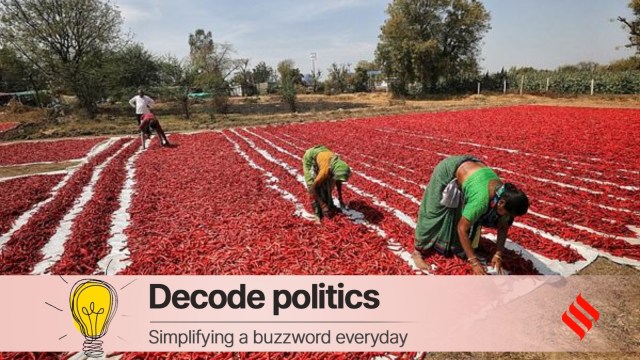Hours after attending the swearing-in event of the Rekha Gupta-led BJP government in Delhi on February 20, Andhra Pradesh Chief Minister and TDP supremo N Chandrababu Naidu reached Krishi Bhawan that houses the Ministry of Agriculture and Farmers’ Welfare, among other Central ministries.
Accompanied by several of his TDP colleagues — including Union Civil Aviation Minister K Ram Mohan Naidu, Union Minister of State for Rural Development Chandra Sekhar Pemmasani, and MP Lavu Sri Krishna Devarayalu — and Andhra government officials, CM Naidu went to Union Agriculture Minister Shivraj Singh Chouhan’s office on the first floor.

While Chouhan was not present, Naidu held a meeting with the Agriculture Ministry officials in the Deen Dayal Upadhyay Hall adjoining the minister’s chamber, highlighting the distress of his state’s chilli farmers amid plunging prices. Chouhan, who was away in home state Madhya Pradesh, joined in by a video link from his car, which halted by the roadside in a remote area for the meeting lasting over half-an-hour.
Story continues below this ad
While it is not uncommon for CMs to visit Central ministries or meet officials, what made this stand out was that Naidu met senior Agriculture Ministry officials while Chouhan was away, along with his two junior ministers Ram Nath Thakur and Bhagirath Choudhary. Chouhan’s office, however, said he was aware of Naidu’s Krishi Bhawan visit and had himself suggested he could join in via a video link.
Why did Naidu want a meeting with the Union Agriculture Ministry?
Naidu’s move was also attributed to the “ugency” of the matter: the TDP chief – a key ally of the Narendra Modi-led NDA government whose party has 16 Lok Sabha MPs – wanted to seek the Centre’s intervention in helping the red chilli farmers of his state, who have been facing losses due to a sharp fall in prices.
 Note: Figures for 2024-25 are based on first advance estimates.
Note: Figures for 2024-25 are based on first advance estimates.
“This year, chilli farmers have been suffering because of prices, incurring huge losses. I asked him (Chouhan) to intervene immediately through market intervention. They (the Centre) have some restrictions – 25% (ceiling under its Market Intervention Scheme MIS) – in procurement. I asked them to remove it to help liberally,” Naidu told reporters after the Krishi Bhawan meeting.
He also asked the Centre to boost red chilli exports besides ensuring a revision of the chilli cultivation cost fixed by the Indian Council of Agricultural Research (ICAR).
Story continues below this ad
Sources said Chouhan assured Naidu that he would hold a review meeting the very next day to resolve the issue, and went on to direct Agriculture Secretary Devesh Chaturvedi and other officials to find an urgent solution in coordination with other ministries.
Chouhan also asked officials to explore the possibility of increasing the exports of red chilli so that “its farmers could get maximum benefit”.
Immediately after returning to Delhi on February 21, Chouhan held a meeting of ministry officials to discuss the issues raised by Naidu. There were two special attendees – Minister Ram Mohan Naidu and an Andhra chilli farmer, who detailed their problems.
What is the problem chilli farmers are facing?
Andhra Pradesh is the biggest chilli producer in the country. Its farmers, mainly in districts like Guntur, Prakasam, Kurnool and Krishna, grow several varieties, such as Teja, Byadgi, DD Best, 341, 273, and 334, which are also in high demand in overseas markets. The Guntur chilli market is the largest in Asia, and determines the domestic and global prices of chillies.
Story continues below this ad
 Note: Figures for 2024-25 are based on first advance estimates.
Note: Figures for 2024-25 are based on first advance estimates.
In the current financial year, the prices of red chilli have dropped significantly. Its wholesale monthly price in Andhra was recorded at Rs 12,297 per quintal in January 2025, which was 3.73% lower than the December 2024 price (Rs 12,773) and 24.97% lower than the January 2024 price (Rs 16,389).
What is the reason for the fall in prices?
The reasons are weak domestic demand and sluggish exports.
“The increasing supply of new arrivals is putting pressure on prices. Despite high stocks of red chilli in cold storage, the demand for older stock has significantly declined, leading to further price drop. The market buying capacity also remains low,” states the latest Chilli Outlook, for February 2025, published by the Agricultural Market Intelligence Centre of Professor Jayashankar Telangana State Agricultural University.
The Chilli Outlook lists several reasons for the decline in prices, starting with weakened export demand, “even with the depreciation of the Indian currency”. “The export markets suddenly changed due to unrest in several countries… the new political regime in Bangladesh, one of the biggest importers of Indian red chilli, is not accepting imports through an automatic route. Similar situation prevails in Sri Lanka as the island nation has cut down imports from India. Poor orders from big importers have dampened the chilli markets,” says the publication.
Story continues below this ad
As per the Union Commerce Ministry data, there has been a 3.22% drop in chilli exports during April-November 2024-25 as compared to the same period last year.
What is the significance of the chilli crop?
Red chillies (dried) are one of the major horticulture crops in the spice category in India, which is the global leader in chilli production besides being its largest consumer and exporter. Chilli is the biggest item among all spices in terms of quantity as well as value.
As per the Union Agriculture Ministry’s first advance estimates (2024-25), red chillies accounted for almost one-fourth (9.22 lakh hectares) of the total 46.55 lakh hectare area under the spice cultivation, and contributed a little over one-fifth (26.93 lakh tonnes) of the total 119.96 lakh tonnes of the country’s spice production.
 Note: Figures for 2024-25 are based on first advance estimates.
Note: Figures for 2024-25 are based on first advance estimates.
Overall, red chillies accounted for 3.19% of the country’s total area (288.39 lakh hectares) under the horticulture crops and just 0.74% of the total horticulture production (362.08 million) during 2024-25.
Story continues below this ad
In 2023-24, chilli made up 39% of the total quantity of spices shipped from India. In value terms too, chilli was the top forex earner among all the spices.
What action is the Centre considering on Naidu’s demands?
Sources said the Centre is likely to relax the 25% MIS ceiling, with the final decision to be taken by the Inter-Ministerial Committee in this regard; Naidu has sought relaxation up to 70%. Under the MIS, the Centre allows states to procure up to 25% of the total production of horticultural / agricultural crops which are perishable in nature and are not covered under its Price Support Scheme. This involves the conditions that either there is a production increase of at least 10% or a decline in prices by 10% compared to the previous year’s rates.
The MIS policy is implemented at the request of the state government, which bears 50% of the loss, if any, incurred on its implementation (25% in the case of Northeastern states). If a state wants to procure over 25%, it has to bear the entire cost.
The Centre has also asked the ICAR to look into Naidu’s demand for a revision of the cost of chilli cultivation.



 Note: Figures for 2024-25 are based on first advance estimates.
Note: Figures for 2024-25 are based on first advance estimates. Note: Figures for 2024-25 are based on first advance estimates.
Note: Figures for 2024-25 are based on first advance estimates. Note: Figures for 2024-25 are based on first advance estimates.
Note: Figures for 2024-25 are based on first advance estimates.





























